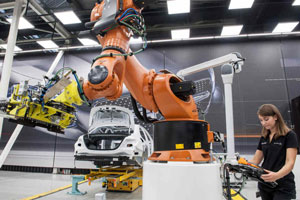KANBrief 3/16

Human-robot collaboration is of elementary importance for the further development of adaptable production installations in Industry 4.0. With the growing demand for innovative technologies, the desire for universally applicable safety concepts is also rising. Daimler AG has developed a strategy of this kind in modular form that can be applied to all collaborative robot projects in the company.
The forward-looking model of human-robot collaboration does not give rise to new hazard classes. Rather, the existing typical hazards must be reassessed in consideration of the new type of overall situation. Risks impacting upon mental stress factors owing to new forms of work organization, work processes and personal skills, possibly also extending to acceptance among the workforce, tend to be application-specific. Conversely, risks that are common to all forms of human-robot collaboration primarily affect the safety concept.
Hazards such as crushing and collision on parts of machinery have largely been eliminated by conventional protective fences and other guards. If these are omitted, the first option considered is the use of electro-sensitive protective equipment to detect persons. However, the strict safety criteria that must be satisfied by these components coupled with a high safety distance results in an installation concept that is barely viable either economically or spatially. In addition, the result can hardly be described as "collaborative", but more as a substitute for the protective fence.
Risk assessment as the starting-point
Consideration of the biomechanical stress factors is an imperative fundamental element of the new safety concept for collaborative robots. These factors can be described as safeguards for the worst-case scenario of a "controlled collision". The risk assessment should have the objective of excluding such crushing and collision scenarios from the outset. This begins with selection and design of the workplace: who is to work there, what are they to do, and what workpieces are to be processed and what tools required for the purpose?
The modular principle: safety, systematically
Once the individual operations have been defined, the next stage is the installation concept. The inherent safety of a robot as an incomplete machine is in fact not the crucial aspect; instead, the overall concept must be safe. This extends to the tool, the workpiece, any further work equipment, and the ambient conditions. A modular approach providing different safety technology for each of these stages (tool, workpiece, etc.) is advantageous. For example, a sensitive robot is of little benefit when the grab is unsafe and sharp-edged parts must also be transferred from A to B. Crushing of the fingers on the grab and cut injuries caused by the part are otherwise inevitable.
In order for efficiency not to be neglected, the working areas must be categorized clearly according to intended use, reasonably foreseeable misuse, and misuse. Clearly defined safety distances and access zones and good organization of the work are but three examples of aspects that must be considered.
Once the overall concept has been produced, the next stage is validation and verification of the remaining crush and collision points. For this purpose, the hazard points must be correlated intelligently to the human body model. Since the work systems are dynamically complex and adaptability is a priority, the safety concept should always be flexible and scalable. These criteria also apply to the measurement system, and can therefore serve as a sound basis for a future simulation model.
Worker instruction continues to be a key element
The risk assessments performed by the manufacturer and the integrator are an essential element of the safety concept. Management of the residual risks by users and operators is at least equally important. The robot's movement processes and safety functions should be made transparent as standard in all instruction provided, in order for installations to be used safely. It should also be ensured that the human being is always in control of the robot and not vice-versa.
Dr Stephan Bürkner
stephan.buerkner@daimler.com